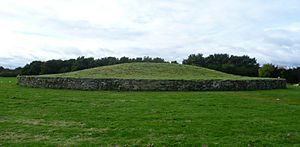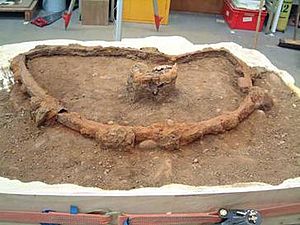Newbridge chariot facts for kids
The Huly Hill burial mound near Newbridge, Scotland, is a very old and special place. In 2004, archaeologists found something amazing there: the remains of an Iron Age chariot burial! This was the first time a chariot burial like this had ever been found in Scotland. It shows that people in Iron Age Scotland had connections with other parts of Europe. The chariot was buried whole, which was common in Europe, but different from how chariots were buried in places like Yorkshire, England.
Discovering the Ancient Chariot
How They Found It
A team from Headland Archaeology and experts from the National Museum of Scotland carefully dug up the chariot. They found that the pit where the chariot was buried was just big enough for it. It was dug deep enough for the chariot's axle. Two smaller pits were dug at the bottom to hold the wheels. A narrow slot held the chariot's long pole, getting wider at the end for the yoke (the part that connects to the horses).
It was clear right away that the iron bands around the wheels and other metal parts were in good shape. The team decided to lift each wheel in a block of soil. This allowed them to study and preserve the wheels carefully in a lab.
What They Found (and Didn't Find)
Sadly, the ground conditions were not good for preserving everything. All signs of a human body had disappeared. However, because chariot burials often included a person, it's very likely someone was buried with the chariot. This burial might have been part of a larger ancient cemetery.
Chariot burials are very rare in Britain. Most others have been found in East Yorkshire, England, as part of the Arras culture. In Yorkshire, most chariots were taken apart before burial. But the Newbridge chariot was buried whole, just like many chariots found in mainland Europe.
The way the chariot was built also shows links to both Yorkshire and European building styles. Experts believe the Newbridge chariot burial happened around 500 BC. This time period is known as La Tene A in Europe. This date fits well with its similarities to European chariots and means it's older than the known chariots from Yorkshire.
Besides the wheels and parts for the horse harness, not many other items were found. Some horse gear was recovered near where the chariot's yoke would have been.



